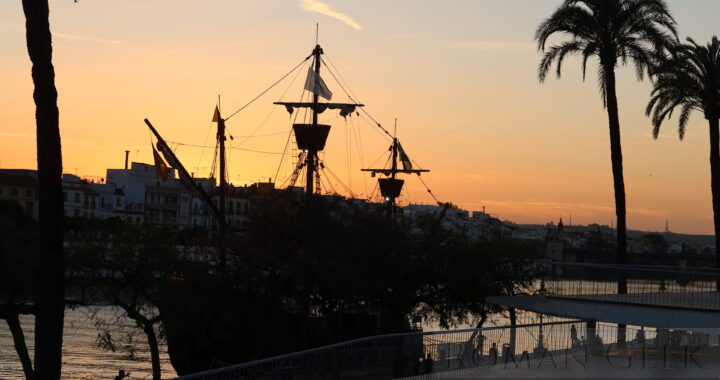- Seville is a cathedral and port city which is the capital of the Province of Andalusia, located on the river Guadalquivir in southern Spain. The cathedral holds the tomb of Christopher Columbus.
- Seville is the only inland river port in Spain, located on the river Guadalquivir 50 miles (80km) from the sea. It holds a number of Roman Monuments.
History
- It was known to the Romans as Hispalis and was in the Province of Baetica.
- Seville was an important Roman port city on the river Guadalquiver, along which Goods such as Olive Oil were exported to Rome.
- It was also on the Via Augusta, the strategic Roman Road which ran from Cadiz to Gaul.
- Nearby were two Roman towns, Carmona and Italica, where the Emperors Trajan and Hadrian were born.
- Hispalis grew in importance in the 2nd century CE, after the River Guadalquivir changed its course away from Italica.
Roman Sites
- Aqueduct ‘Canos de Carmona’
- Four arches remain from the 1st century BCE aqueduct.
- Columns of a Roman Temple (possibly dedicated to Hercules)
- Three 30 feet high (9m) granite columns in Marmoles Street.
- Roman Columns
- Located in La Alameda de Hercules, a garden square.
- Two Roman columns were moved from the Marmoles street Roman Temple, and are topped by modern statues of Julius Caesar and Hercules.
- Roman Walls
- reconstructed under the Moors.
Museums
- Archeological Museum of Seville
- Located in Plaza de America, Seville.
- The museum holds the Finds from the Roman Ruins of Italica.
- Antiquarium
- An Archeological Museum located in the basement of a structure known as the Metropol Parasol, in the Plaza de la Encarnacion, Seville.
- It holds Roman Mosaics from: the House of the Nymph, the House of Bacchus, the 10 foot (3m) Mural of the Ocean Courtyard, House of the Column (Medusa and jellyfish mosaic), House of the Bases, the House of Sigma, the House of the Ferris Wheel and the Hospitium of the Dolphins.
The General Archive of the Indies
- This is housed in the Merchant’s Exchange Building in Seville.
- There are 43,000 works relating to the History of the Spanish Empire in the Americas and the Philippines from the 16th to 19th centuries.
- Many logbooks of the Spanish Galleons are preserved here.
Replica of the Nao Victoria (‘Carrack Victory’)
- The first circumnavigation of the globe in history was conducted by the Magellan-Elcano Expedition between 1519-1522. After Magellan was killed in the Phillipines, Elcano brought the expedition home.
- The Nao Victoria (meaning the Carrack Victory) left Seville in 1519 commanded by Elcano in 1522.
- The replica moored in Seville was built in 1992.
Roman Roads
Nearby Sites
- Italica
- Located at Santiponce, 7 miles (11km) to the north of Seville.
- Carmona
- Located 20 miles (33km) northeast of Seville in Andalucia, Spain.
Walls of Seville

